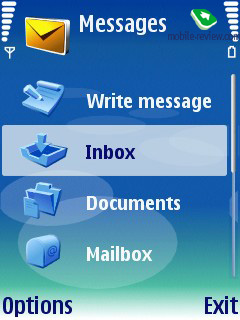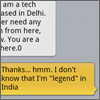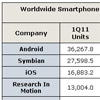Spillikins #123. Modern Mobile IM clients – Microsoft's approach vs. Apple's
The last week did not predispose me for work: a couple of days in Moscow, then I had to go to Ibiza to give a speech and I decided to stay there for a while. There is almost no Internet connection in the hotel so I have not been able to participate on forums or post in my blog. I tweet on my Blackberry and visit a few pages a day but all in all this is my vacation from the worldly vanity and the Internet. Everyone needs it every once in a while to get a fresh look on things. However, there have been lots of events that require our attention, the most important being, of course, the announcement of Apple iOS 5. This event has already been covered by our reporters and a detailed review of iOS 5 is coming soon.
As soon as I get a proper Internet connection I am going to review the Apple cloud services. The topics of this issue are things and events that have drawn my attention in the recent days. The center of my attention was Microsoft for many reasons. But I want to start with instant messengers of today.
Contents:
- Instant Messaging – My Thoughts for Joe Belfiore
- Microsoft Gives Phones Away in the USA
- MOTOBLUR Title is Dead
- Nokia: New Resignations and Related Events
- Screen Defects in Samsung Galaxy SII
Instant Messaging – My Thoughts for Joe Belfiore
Last immediately following the announcement of iOS 5 Joe Belfiore, head of Windows Phone 7 development, tweeted that he felt flattered that some new functions Microsoft had presented not so long ago were adopted by Apple. Here are the two original posts:
- Feeling flattered today. Lots of great WP ideas headed to iOS. (Camera button/above lock, auto-upoad of pics, better notifications ... ) Source
- Feeling flattered today part 2 ... wi-fi sync, built-in twitter, background downlad service, short-messaging chats (though we do Facebook!) Source
I felt a bit offended by the fact that Microsoft consider iMessage a copy of the messenger we see in Windows Phone 7 Mango. They do have something in common but I don't think they can be called identical. I replied to Joe's tweet saying that the messengers only look similar while they are based on completely different ideas. I did not want to overencumber my tweets so I decided to move the discussion here and, I believe, many companies can learn from it.
Chat functionality appeared in mobile phones a long time ago. At first, such apps were merely ported PC versions with no multitasking – you could only send and receive messages while your messenger was active. You could never be sure that your message was delivered – there was no way to check it. But besides the technical aspect there was also a social one. In most cases people had contacts in their messaging clients who were not present in their phone books – net acquaintances.
With the development of mobile communication personal mobile phone numbers were often indicated in IM and similar clients. ICQ, for example, has had the SMS delivery service for a long time now so you can contact people even when they are not online – a bridge to the real world, so to say.
But until 2007 the chat concept was not used in IM messengers in phones. The ideology was different and it was based around SMS – you receive a message and you reply to it. you could not have a comprehensive look at the history of messages with a contact. This simple idea was not used until Apple iPhone. Today, however, this principle is universal.
In 2009 during the development of Nokia N97 there was an idea of letting the user choose any convenient way of replying to an SMS but it wasn't put into practice. This idea was in the air and back then we saw many applications that combine several IM messengers. These applications combined had only a common contact list and their cores were the application themselves not the user. In Windows Phone 7 Mango the user has finally become the center of communication – it does not matter what app you use you will receive messages from any IM application like Facebook Chat or SMS and all your messaging will be displayed as a chat.

More details on the Microsoft Messenger in the official blog.
I want to note the key points that I believe to be important for this messaging service:
- MPOP (Multiple Point of Presence) – you can run the Messenger on your PC and your phone so messages will be delivered to both devices. This is similar to how Skype works.
- Group messaging (to service that support this).
- Support for the open XMPP standard;
- No PUSH messaging.
- You can't save messaging history.
- Integration with Facebook Chat;
- There is no delivery or read report feature for Facebook Chat and other third party applications.
So I think it is clear that modern mobile messaging implies integration with similar PC services. But what is the main difference between these services and SMS? The difference is that the delivery of an SMS is granted by the carrier and you can always get a message status report. While message delivery in modern IM clients is NOT guaranteed – we can only hope it gets through. This is a huge difference that allows me to say that the messaging concept used in Microsoft Windows Phone 7 has so far one but a considerable flaw – it puts together guaranteed message delivery services (SMS) with probable services.
I am not a fan of abstract analogies but the developers of this service used the idea that a phone is always connected to the Internet and in most cases that is true. But not always: let me draw an analogy with letters – on the one hand we have registered letters delivered personally and on the other hand there are regular letters that will only get as far as the addressee's mailbox. In the second case the mail service will not check whether the addressee reads or even receives the letter. But when we send a letter we want to follow it. In case of SMS we can know precisely when a message is delivered. This is a completely different approach to delivery: we can be sure that a message will be delivered since the carrier is responsible for it and we can know whether the addressee got to read it.
Let's consider Skype that has a chat service. The very nature of Skype presupposes that messages cannot be delivered while the addressee is offline. This is a serious downside of the application – the chat feature cannot be fully realized. You can never know ether the person you need to contact will be online when you want to text him. This Skype example serves well to illustrate how Windows Phone 7 works. Skype can work on the assumption that people are online all the time for messages to be delivered instantly. But in real life you sometimes receive messages several days after they were sent. Many people are ready to put up with this downer for cheap voice calls which are the anchor service of Skype. While in phones SMS is the anchor service.
Let's now look at SMS from the point of view of a regular user. Everyone uses it because it simply works and it is very easy to use. It is always a standard service in a carrier's package no matter how you pay for them (per message, per a number of SMS or you have an unlimited plan). A user would prefer SMS over IM clients for reliability and swiftness. It is a perfect means for personal communication when you need an answer quickly. It is also used as a corporate means of communication though for a lesser extent – it has to compete with email.
The Microsoft's approach is simple – let the user see all the messages in one place: from both reliable and unreliable services. The company has missed one very important issue – the user cannot get a delivery report besides SMS. Most messages will be delivered immediately but you have no means to check it. You can only know whether your message has been delivered and read only when the addressee responds to it.

Initially, Blackberry considered integrating SMS into a common chat but users did not like it. The BBM client is different because it shows the delivery status and it is not cross-platform – I mean it is designed to work only with other Blackberries and cannot interact with other IM clients. I don't think this is a downside of this client because the delivery status check together with SMS makes up for it. the rapid popularity growth of the KIK messenger is a proof that users liked this idea and they needed delivery reports though, of course, none of them gave up Facebook Chat, Google Talk or other apps for KIK or BBM.
Today there are about 87 applications that use the XMPP protocol derived from Jabber. Most of them don't have the delivery or read report feature. It is a different world which is very different from what BBM, KIK and Apple iMessage offer.
I had to make this lengthy intro to make my point about the differences in approaches taken by Microsoft on the one hand and Apple and Blackberry on the other. In the first case we see an attempt to integrate various services sacrificing the reliability of delivery and information about the delivery. While in the second case the companies are not saying that SMS are redundant they just leave SMS as a separate service (which also goes easier on the carriers' nerves than the Microsoft's approach), they merely complement SMS with other messaging services (which make communication free if Wi-Fi is available). These are two completely different approaches and as the practice shows the latter is more successful (Blackberry, KIK and now Apple). Microsoft is offering an interesting concept which will not become wildly popular simply because there are not many WP7 handsets.
Apple also has the advantage of the brand value. Today there are about 200 million iOS devices in the world. Naturally, many iPhone users also have an iPad or an iPod Touch so the iMessage audience is much smaller (I would estimate it to be around 120-130 million). But even that is a humongous number and it is practically a new market for Apple. And this new Apple service is easy to use – you don't need to switch between your accounts and search where your addressee is online. If he is not available in iMessage you simply send him an SMS from another application. There can't be any confusion. This is very easy to use and the market loves simple things. The Microsoft's product is interesting for geeks and enthusiasts but it won't interest the mass market. It is an issue of the tasks the Windows Phone team puts forward.
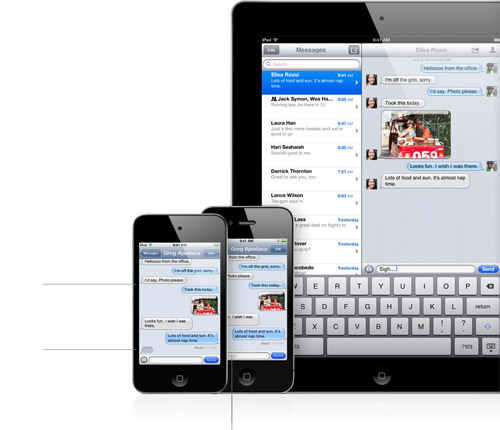
Despite the superficial similarities between the IM clients by Apple and Microsoft the former belongs to the Blackberry Messenger class and by no means to Facebook chat and others. The PUSH feature makes the delivery instantaneous and saves the battery charge. The Microsoft's client offers a wide range of IM clients all in one place but it is an attempt to mix fundamentally different services. In my opinion, the perfect solution for Microsoft would be to add a guaranteed delivery feature and PUSH service – this would dramatically improve their product and allow this client to catch up with iMessage or even get ahead of it. But this solution implies solving a lot of problems.
I hope that this response to Joe Belfiore's tweet has not bored you. I think it is of utmost importance to understand the difference between services in the plain of fundamental approaches. This is not a matter of realization, interface sleekness or user friendliness. It is a matter what certain services can offer. I presume that I have not considered some important issues here so invite my dear readers to join me and Joe Belfiore in this discussion. I will gladly reserve space for his thoughts here in the Spillikins. I am looking forward for having an interesting discussion.
Back to the table of contents >>>
Microsoft Gives Phones Away in the USA
We have already mentioned weak sales of Windows Phone 7 and this OS is still struggling to get a foothold in the market. Microsoft tries hard to change the situation. In the official Microsoft store US customers can buy one of WP7 models for a cent. This offering is available for three US carriers – Verizon Wireless, Sprint and T-Mobile. Interestingly this option is available not only for new 2 year subscriptions, which is typical of the US market, but current clients can also get this update. It looks very accessible and means that WP7 sales are well below expectations and Microsoft is doing everything to increase the promotion of the product.

I would like to remind you that at D9 conference Ralph de la Vega (CEO AT&T Mobility and Consumer Markets) mentioned the following about WP7:
"We actually like that software very, very much. It hasn't sold as well as Microsoft or us would want it to. I think for the first thing out of the chute it is pretty good. I think they just need to make it better… Giving customers more application choices, having a bigger app store with more functionality on the phone–I think that is all that it needs."
Related articles:
Back to the table of contents >>>
MOTOBLUR Title is Dead
Motorola decided not to promote its phones with MOTOBLUR shell as it does not increase the value of their solutions. Android does the trick automatically, while additional names scare customers. I imagine the conversation in a store:
- What model are you looking for?
- I need something with Android on board.
- We have one with Android, which also features MOTOBLUR.
- Thank you very much! I need only Android.
- Look at this Chinese model then.
Motorola will keep on developing their own shell, but it will not be marketed as such. That's the only difference.
Back to the table of contents >>>
Nokia: New Resignations and Related Events
Events around Nokia are becoming more farcical with every coming day. Last week WSJ mentioned that Samsung is planning to snap up the phone department of Nokia. These rumors are grounded as they are started by Nokia itself. The shares of the Finnish manufacturer are in a freefall and the company is trying to stop the rot and get as much as they can from a real suitor by pitting two contenders against each other. The point is that Samsung has no reason in buying anything from Nokia at the moment. It is enough for them to wait and see how Nokia is destroying its empire. Nokia has nothing at the moment to sell to Samsung. The latter has a similar or better logistics schemes all around the world and unlike Nokia Samsung boasts its own development and production of components. Some Nokia patents may look attractive, but their price is going down with the fortunes of the company.
The CEO of Nokia Stephen Elop was quick to comment on the information and labeled it groundless. There is a strange feeling about who and why generates these rumors.
What is interesting is that the CTO of Nokia Richard Green walked away from the company. Unsatisfied with the direction of current development he merely stopped coming to work. He was largely hired to develop MeeGo together with Intel, so his days were numbered, but it is still a heavy blow for Nokia and its reputation especially taking into account the manner of the departure.
Against the background of negative news from Nokia's partners and components suppliers we can say that the latest development adds insult to injury. Let's look at what happens from now on and who is going to be the next to jump the sinking ship. The most talented and capable have already started their exodus for pastures new. On top of that the captain of the ship does not try to steady it, but rather steers it to even more treacherous lands.
Related reading:
Back to the table of contents >>>
Screen Defects in Samsung Galaxy SII
I started receiving questions about screen defects in Samsung Galaxy SII a month ago and the tone was accusatory. I will quote a letter I received next day after the issue was mentioned for the first time on XDA Developers (they were the first to highlight it). So comes the letter:
"I purchased Galaxy S2 and found a defected screen in the model. It has a bright yellow stripe on the left. It is visible in the browser when you have a minimum backlight and adopt grey background. Why have you blamed Nokia for the purple color in N8 so vehemently and keep mum in this case? Did Samsung pay you for that? I demand from you the immediate publication of the news that all SGS2 models have defected screens. Consumers should not suffer for that".
This emotional letter made me smirk as I get them regularly and the bulk of the mail has nothing to do with real problems. I have three commercial Galaxy SII models on my hands and I found no issues whatsoever by utilizing inbuilt test tables. Afterwards I was explained how to get the abovementioned yellow stripe.
The procedure is the following. First disable the automatic screen brightness and set it at 20%. Then download the grey background in the browser or a special picture (you need a special grey color). That was where I had a problem. None of my phones could show the yellow stripe. A recommendation of genius follows. As far as the defect cannot be seen with the naked eye take a picture of the screen to spot the yellow stripe. Did you get it? Take a picture to see the yellows stripe on the photo! As simple as that!
How can we compare this issue with the one in Nokia N8? In that model you cannot watch video properly due to irregular colors. For Samsung you need to create a special environment and take a picture to get the desired yellow stripe otherwise invisible.
I am not going to defend Samsung, but the situation looks weird. To prove the defect you have to create an artificial environment and then take a picture of the screen. It's crazy! I do not know whether users may really suffer from the issue in everyday life. I am sure those who wanted to criticize the model found a pretext here. You have to be ingenious to prove that an excellent screen has drawbacks.
I asked several times to give me photos of the defect. Some people claimed they managed to get the yellow stripe, while others said they see yellow stripes in real life too. The funniest things happen in Russia where only two people referred to the service centre with a similar claim during one moth of sales. It means almost nothing as the model just started selling. In the UK the phone appeared in shops at the same time, but once again we have no more than 20 claims probably triggered by the story on XDA Developers.
Samsung paid a lot of attention to this situation, which is always required from one of the leading manufacturers. Their research shows that there was no defect of components and the majority of users will not be able to replicate the trick with the yellow stripe. Who was interested in discussing the defect of components if it was never the case? I advise you to look at several photos supplied by users to XDA Developers and claiming they had the defect in the handsets. I think it is more of a psychological phenomenon rather than the model's deficiencies.
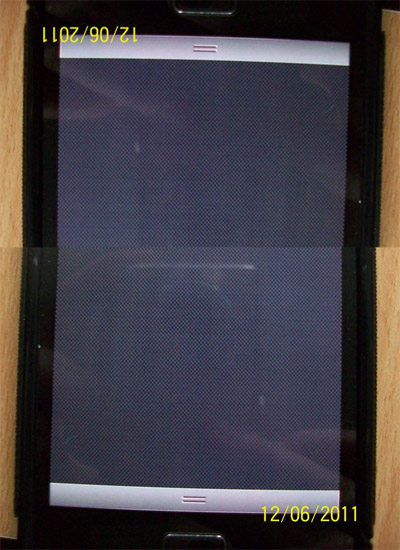
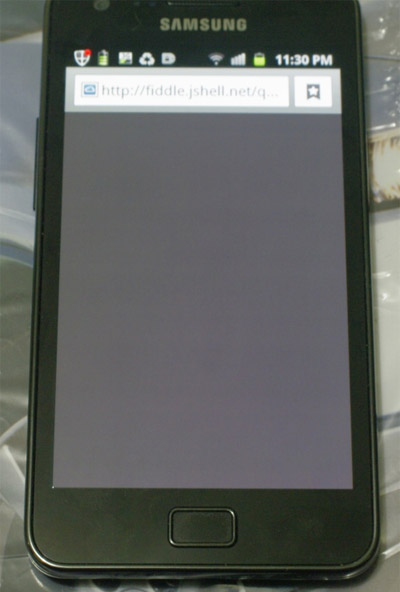
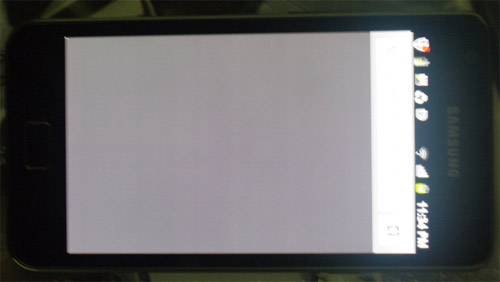
I do not consider artefacts you can detect only with another device as defects. Under the microscope you could probably see that not all components of the microchip board are even. Is it a defect? Anyway, I am always open to your messages and photos with the defected screen. May be everything I mentioned above is my mistake and you indeed have a defected model on your hands, which can be delivered to the service centre for them to handle the issue. Thank you very much in advance!
P.S. Have a nice week and be happy!
Do you want to talk about this? Please, go to our Forum and let your opinion to be known to the author and everybody else.
Back to the table of contents >>>
Related links
Eldar Murtazin (eldar@mobile-review.com)
 Twitter Twitter  Livejournal Livejournal
Translated by Maxim Antonenko (maxantonenko@ukr.net), Robert Mugattarov (mugattarov@gmail.com)
Published — 19 June 2011
Have something to add?! Write us... eldar@mobile-review.com
|

